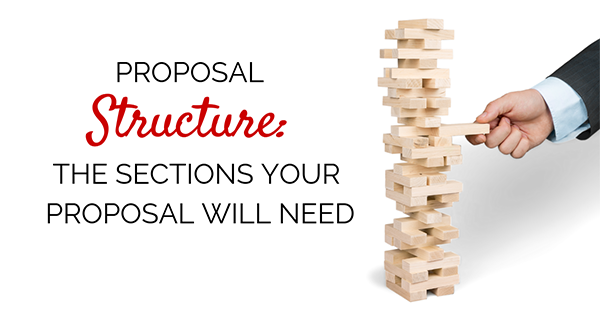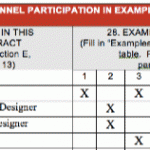
Your proposal structure will contain several sections. Your proposal may have some or all of these sections depending on what information your client asks for.
Let’s explore what a proposal format might look like by getting to know the sections you might include in your proposal.
The 3 Primary Sections In Your Proposal Structure
Most proposals contain these primary sections.
Project Understanding
This is where you state your understanding of the client’s problem or need. It helps the client understand why he or she should be reading this. This is sometimes called, “pushing the pain button.” You’ll also want to describe the end result, the “happily ever after” that results from your work.
Let’s be frank. You want something. That’s why you are submitting a proposal. You are asking someone for something, most likely money in exchange for something.
But in the Project Understanding, we are going to forget what we want and focus entirely on the person (or people) we are submitting this proposal to.
What is their current situation? What challenges are they dealing with? How does this affect them? How will their situation improve once they’ve chosen to give you what you want?
Remember, this is about them, not about you.
The Ouch Button
First, we are going to push what’s known as the “ouch button.” We are going to remind them the pain they or the people they serve experience.
For example, if their building is falling apart and you are proposing to fix this, you’ll write about any concerns they might have about safety. Maybe the building doesn’t provide the facilities they need to operate efficiently.
Maybe you are proposing to design a new community center. In this case you might want to write about the local children or seniors who have no place to go. They are left to sit at home by their lonesome.
Help them feel the pain of the problems their situation presents. But always keep this next point in mind.
It’s Not Their Fault
You never want to tell the person you are proposing to, or even infer, they did something wrong. Remember, it’s not their fault!
Even if they failed to keep up with the property and it’s now a hazard to the community, it’s not their fault.
I can’t emphasize this enough. The person you are proposing to is never the villain. They are always the hero. They are the person who has the power the make things better.
Creating Contrast
After you describe the current situation, you have to create contrast. What would the situation look like if it were fixed?
How many more customers could they get if they redesigned their website? What would the children’s reaction be if they built that community center? How would a better-designed facility or a software solution make their life easier?
Write that down next.
Key Issues
Just to “hit it home,” it may also be helpful to summarize your project understanding by highlighting a few key points.
Scope of Work/Approach
Sometimes you will define the scope of work. The scope of work is what you will do for the client. What actions will you take to fulfill the client’s need or solve their problem? Proposals are often later attached to contracts. They are, in a sense, legal documents.
Therefore, you need to be not only honest but very specific in your proposal. You need to state exactly what you are going to do for the client. Often a client will provide you with a scope of work and ask you to address how you will approach this scope. In this case, you need to explain how you will perform the tasks outlined and give the client a “warm and fuzzy” that you know what you’re talking about.
Technical Approach Or Scope Of Work
Now that you have described the problems and challenges your client faces, the next step is to outline your proposed solution.
If The Client Has Not Given You The Scope Of Work
If a client has provided you with an RFP, it is likely they have included a “scope of work.” A scope of work outlines the tasks you are to complete.
If the client has not provided a scope, it’s up to you to do so.
Sit down and think this through. What steps are you going to take to get the client to the positive outcome we described in our Project Understanding?
Write down each task you will complete. There isn’t just one or two. There should be several. Be very specific.
Also, describe the deliverable for each task. A deliverable is what you will give the client after the task is complete.
For example, the first task might be a kick-off meeting with the client. This might be a one-hour meeting so the client can get to know the team. Plus, the team can ask a question or get clarification on the client’s objectives.
The deliverable for a kick-off meeting is likely “meeting minutes” that someone on your team will record.
Each solution is different so nobody can write this scope for you. That’s because only you know what you are willing and able to provide a client.
If The Client Has Provided A Scope
If the client has provided a scope of work, you need to provide an “Approach.”
An approach is not:
- What tasks you will do
- A description of your experience or why you are so great.
An approach describes the “how” and “why” for the tasks the client has provided.
It’s best to start out your approach by describing your general philosophy when it comes to providing these services.
For example, if you design websites, your general philosophy might be that websites should be:
- Easy for the average person to update
- Built on an established open source CMS so they can be redesigned easier later.
- Optimized to show up on the first page of Google for at least one key term
- Optimized to load the first byte within a second
Next, you will go through the scope of work provided by the client. For each task, describe how you will do the task and why you will do it that way.
For example, let’s say the first task of a client’s scope is:
“Provide recommendations for a new Client Relationship Management System.”
Well, how are you going to do that?
There is a lot you might not know. Are they already using a CRM? What do they want to accomplish using this CRM? What is their budget? Do they prefer to host this system internally?
To accomplish this task, you’ll first have to gather some information from them. Describe how you’ll do that. Will it be a survey? Will it be a face to face meeting or phone call?
Then describe the advantages of gathering information this way. Maybe sending them an online survey is best because the client is very busy and won’t have time to meet. Maybe a face-to-face meeting is better because their answers might lead to more questions and you don’t want to make them meet twice for this task.
If the client has not provided deliverables, you will have to define the deliverable for each task. In the CRM example, the deliverable might be a list of three suitable CRM options compared by price and features. This might also include your recommended CRM and reasoning for this selection.
Pricing
Once you’ve told the client what you can do for them, they’ll want to know how exactly how much it will cost.
I could write a book about pricing. In fact, in my Proposal Development Secrets book, I devote two whole chapters to pricing.
But here are the basics you must understand when putting your pricing together.
There are three common ways to price:
- Lump Sum
- Hourly
- Hourly with a Not To Exceed Price.
If you do lump sum pricing, you should break down the costs in a table. If you do hourly pricing, you should break out the hourly rates for each category of staff working on the project.
If an RFP requests specific pricing information, you better provide it.
Reimbursable Expenses
Reimbursable expenses are costs (like travel, printing, etc.) that are not included in your price but you will incur during the execution of your work. Typically, these costs are billed to the client “at cost” or with a 10% markup. You need to address reimbursable expenses in your proposal. Otherwise, don’t expect to get reimbursed for them.
Payment Terms
If you have any payment terms, like “net 30,” you need to state them in your pricing or attach terms and conditions.
Assumptions and Clarifications
In this portion of the pricing, you should indicate the assumptions your pricing is based upon. For example, if you are proposing to provide tree removal services, then one of your assumptions is probably:
We assume there are no underground gas lines within five feet of this tree.
If you start digging a tree up and hit an underground gas line, that’s going to be expensive. That’s just one example of why assumptions and clarifications are so important.
Identify every assumption and be very clear about what you won’t be providing.
Other Proposal Sections
There are a few other pieces of information your client might want to see in a proposal. Even if you are not asked to provide this information, it might be in your best interest to include it.
Letter of Interest/Executive Summary
A letter of interest or executive summary answers the following question, “What are you going to do for me and why should I hire you?” Basically, this is one or two pages that make your case. This should provide your client all the information needed to convince your client to say, “yes.”
Cover letters, or executive summaries (which what I’m about to say also applies to), are one of the most important pieces of a proposal.
99% of the cover letters I’ve seen during my years are cr* p. The problem stems from common misconceptions about the cover letter’s place in the current proposal environment.
Let us look at three misconceptions that can lead to epic cover letter failure.
Misconception # 1: People Want To Read Your Cover Letter
Recently, I was at a pre-bid meeting. The Director of Construction made it plain.
“Do not provide a cover letter in your proposal. It’s not going to persuade us. So, do not waste your time.”.
Exactly why would he state that?
He said that due to the fact that he’s seen hundreds, if not thousands, of cover letters and they all said virtually nothing. There was nothing useful in those cover letters. Naturally, when he sees a cover letter, we have trained his brain to skip over it.
You are insane if you think someone is likely to read your cover letter just because it is there.
Instead, you need to give folks a reason to read your cover letter. You need to get their attention and then create a “slippery slope” that will keep them reading.
You have to start off by creating a “knowledge gap.” You create a knowledge gap by highlighting a gap between what the reader knows and what the reader wants to know. Let’s say you are an architecture firm proposing to a client that knows you pretty well. You could use, “3 Things You Might Not Know About ABC Architects.”.
Those three things better be something they don’t know and also highlight what they would be missing out on if they hire a different firm for this project.
Obviously, this is an approach I’ve also used quite successfully in proposals to clients all over the country.
Misconception # 2: You Can Replicate Someone Else’s Cover Letter.
People often get frustrated when they ask me for an example of a great cover letter for them to use. Because I tell them such a thing does not exist.
An exceptional cover letter to the Department of Veterans Affairs is not going to be an awesome cover letter to the University of California Health System.
Each cover letter has to speak to the specific client and project. That means, gasp, each cover letter will have to be written from scratch. There is no way around it.
Well, actually there is. Write a terrible cover letter they will simply skip over. That won’t help you win.
Misconception # 3: Throw Everything At Them and See Exactly What Sticks
This mistaken belief leads to lengthy cover letters. Here’s the problem.
If you had been given a three-page letter in 1973, the probability that you would have read through all three pages would have been extremely high.
But we inhabit a different world. When was the last time you read, word for word, a three-page letter?
Even better yet, when was the last time you even received a three-page letter?
I’m saddened to say that if my own grandmother sent me a three-page letter, she’d be pressing her luck. I couldn’t guarantee I’d read through ever word.
Busy individuals simply do not read long cover letters. Just about anything longer than a page is pushing it.
Two-page cover letters are sometimes inevitable. However three-page cover letters are simply always avoidable.
Every word must earn its place on the cover letter. If it doesn’t speak specifically to this client, it simply hasn’t earned its way onto the page. As much as this pains you, leave it out.
Don’t let these misconceptions plague your cover letters. Follow my advice and you’ll get an opportunity to make a powerful pitch to your clients.
Relevant Experience
Relevant experience is defined as instances where you helped a similar client solve the same challenge or clients just like them who decided to hire you.
Let me ask you a question. Would you let a dentist perform brain surgery on you? No.
Would you let someone who has never cut hair, do your hair?
No way.
The reality of the world is nobody wants to hire someone who hasn’t done it before. Yes, that sucks for you if you are just starting out.
In the relevant experience section of your proposal, you’ll list the experience that proves you can do it. You might have to get creative with how you describe that experience, but always be truthful.
Describe what you’ve done for other clients just like them. Five relevant projects should be plenty. If you have three relevant projects and two that are stretch, just use three. But ultimately, you should have at least one.
If you can, add photos and contact information for your previous clients.
Qualifications Of The Team
This details who will be working with the client and what their qualifications are. It often contains resumes or bios of the team members.
Ultimately, your client will want to know who is going to do the work. That’s why resumes for your team members are important. Most RFPs will ask for resumes.
And most people really screw this up. They throw in long, boring resumes. Clients are forced to figure out, if possible, how this person’s experience is relevant.
Don’t make your clients think! Provide short resumes that explain exactly why these people are the perfect fit for this contract. Keep it extremely relevant.
Organization Chart
I’m not really sure why clients often ask for this, but I imagine they want to know who is in charge of each aspect of the assignment. They probably also want to know who to contact if there is a problem.
It’s in your best interest to make the organization chart “stupid simple.” If a monkey can’t understand it, you are doing yourself a disservice. These elements, based on the need of your proposal, make up the proposal format.
Read The Other Sections To My Ultimate Guide To Proposal Writing
The article you just read is one section of my Ultimate Guide To Proposal Writing.
Click on the links below to read the other parts.
- Part One: Proposal Writing Basics
- Part Two: The Proposal Structure
- Part Three: The Proposal Writing Formula
- Part Four: The 3 Golden Rules Of Proposal Design
- Part Five: Proposal Templates: What You Need To Know
- Part Six: Architecture, Engineering, and Construction Proposals: How To Write Them





[…] Part Two: The Proposal Structure […]